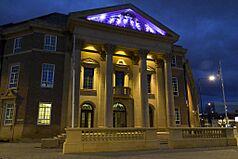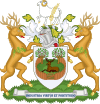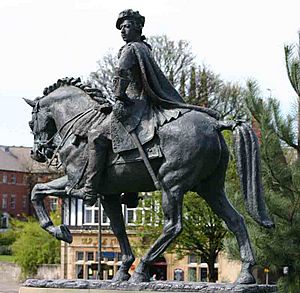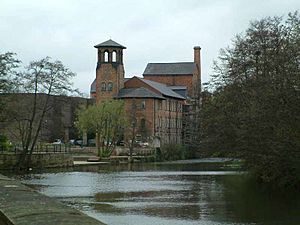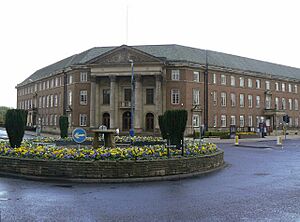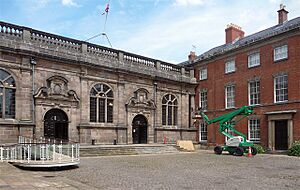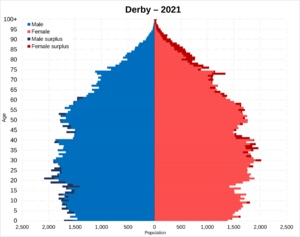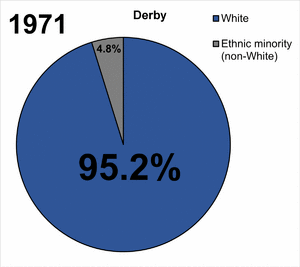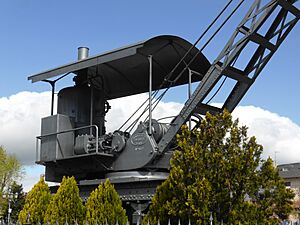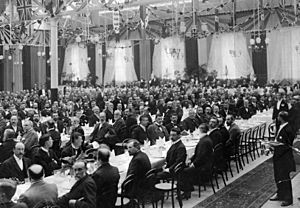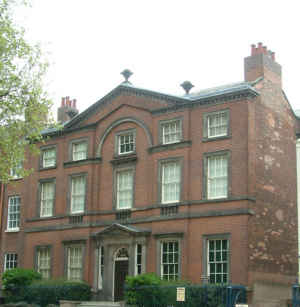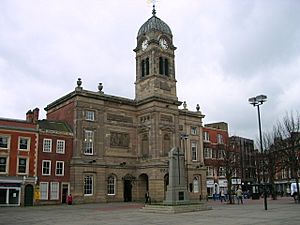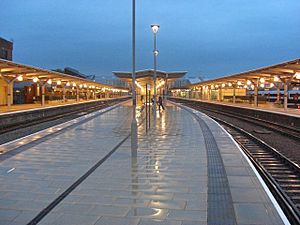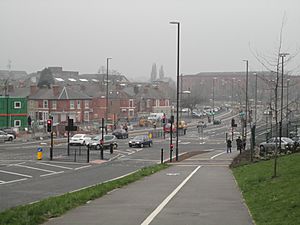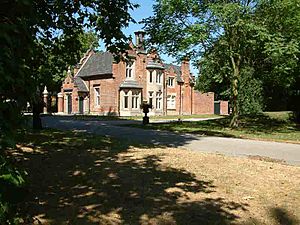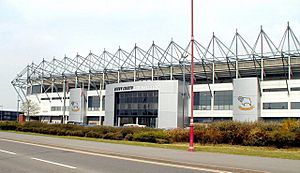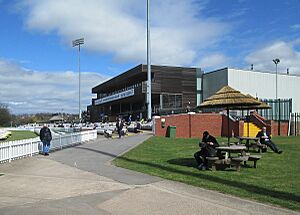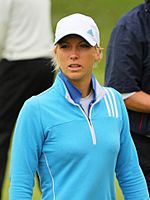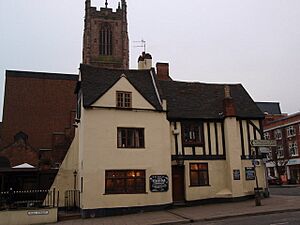Derby facts for kids
Quick facts for kids
Derby
|
||
|---|---|---|
|
City and unitary authority
|
||
|
Council House
Sadler Gate
Museum of Making
Cathedral Quarter
Derby Cathedral
The Quad
Arboretum Park
|
||
|
||
| Motto(s): | ||
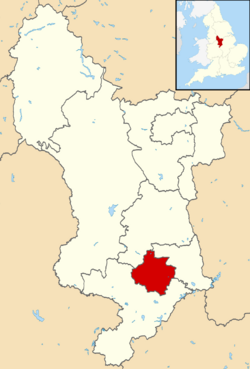
Shown within Derbyshire
|
||
| Sovereign state | United Kingdom | |
| Country | England | |
| Region | East Midlands | |
| Ceremonial county | Derbyshire | |
| Settled | 600 | |
| City status | 1977 | |
| Unitary authority | 1997 | |
| Administrative HQ | Council House, Derby | |
| Areas of the city (2011 census BUASD) |
List
Allenton
Allestree Alvaston Alvaston Moor Alvaston Village Boulton Boulton Moor Breadsall Hilltop Cavendish California Chaddesden Chellaston (Village) City Centre Crewton Darley Abbey Derwent Heatherton Village Kingsway Little Chester Litchurch Littleover Mackworth Estate Markeaton Mickleover (Town) New Zealand Normanton Oakwood Osmaston Pear Tree Sinfin Shelton Lock Spondon (Village) Sunny Hill |
|
| Government | ||
| • Type | Unitary authority with leader and cabinet | |
| • Body | Derby City Council | |
| Area | ||
| • Total | 30.13 sq mi (78.03 km2) | |
| Area rank | 246th | |
| Population
(2005 est.)
|
||
| • Total | 257,302 | |
| • Rank | 67th | |
| Demonym(s) | Derbeian | |
| Ethnicity (2021) | ||
| • Ethnic groups |
List
|
|
| Religion (2021) | ||
| • Religion |
List
40.2% Christianity
36.6% no religion 11.1% Islam 3.7% Sikhism 1.2% Hinduism 0.3% Buddhism 0.1% Judaism 0.5% other 6.3% not stated |
|
| Time zone | UTC+0 (GMT) | |
| • Summer (DST) | UTC+1 (BST) | |
| Postcode area |
DE1, 3, 21–24, 73
|
|
| Dialling code | 01332 | |
| ISO 3166 code | GB-DER | |
| GSS code | E06000015 | |
| ITL code | TLF11 | |
| GVA | 2021 estimate | |
| • Total | £7.5 billion | |
| • Per capita | £28,627 | |
| GDP (nominal) | 2021 estimate | |
| • Total | £8.4 billion | |
| • Per capita | £32,025 | |
Derby (![]() i/ˈdɑːrbi/ DAR-bee) is a city and unitary authority area in Derbyshire, England. It sits on the River Derwent. Derbyshire is actually named after Derby, which used to be its main town. As a unitary authority, Derby manages its own affairs and is separate from Derbyshire County Council. The population of Derby is 257,302 (2020).
i/ˈdɑːrbi/ DAR-bee) is a city and unitary authority area in Derbyshire, England. It sits on the River Derwent. Derbyshire is actually named after Derby, which used to be its main town. As a unitary authority, Derby manages its own affairs and is separate from Derbyshire County Council. The population of Derby is 257,302 (2020).
Long ago, the Romans built a town here called Derventio. Later, the Anglo-Saxons and then the Vikings took over. The Vikings called it Djúra-bý and made it one of the Five Boroughs of the Danelaw, which were important fortified towns.
Derby started as a market town but grew quickly during the Industrial Revolution. It was home to Lombe's Mill, one of Britain's first factories. The southern part of the Derwent Valley Mills World Heritage Site is also located here. When railways arrived in the 1800s, Derby became a major hub for the British rail industry. Even though it had a cathedral since 1927, Derby didn't officially become a city until 1977.
Today, Derby is known for making advanced transport equipment. It's where Rolls-Royce builds engines, and Alstom (which used to be Bombardier Transportation) has a train factory. Toyota's UK headquarters is also nearby in Burnaston. With its old buildings and rich history, Derby is also a popular place for tourists.
Contents
- History of Derby
- How Derby is Governed
- Geography of Derby
- Derby's Population and People
- Derby's Industries
- Famous Landmarks in Derby
- Getting Around Derby
- Community and Culture in Derby
- Sports in Derby
- Shopping and Nightlife in Derby
- Education in Derby
- Media in Derby
- Notable People from Derby
- International Connections
- Freedom of the City
- See also
History of Derby
What's in a Name?
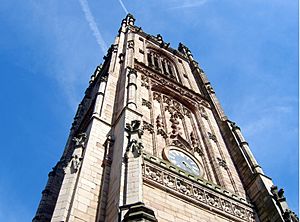
The Roman camp of Derventio was located at Little Chester/Chester Green. Later, the town became one of the "Five Boroughs" (fortified towns) of the Danelaw, an area ruled by Vikings. In July 917, Lady Æthelflæd of Mercia captured it, and Derby became part of the Kingdom of Mercia.
The Viking name Djúra-bý meant "village of the deer." In Old English, it was called Deoraby. The name Derby might also come from the original Roman name Derventio, or from the River Derwent, which means "valley thick with oaks." So, "Derwent by" could mean "Derwent settlement."
Old maps, like one from 1610 by John Speed, show the town name as Darbye. Recent studies suggest that Vikings and Anglo-Saxons lived side-by-side in two areas separated by water. The Anglo-Saxon Chronicle (around 900 AD) even says "Derby is divided by water." These areas were called Norþworþig ("Northworthy" or "north enclosure") and Deoraby.
Derby in the 16th to 18th Centuries
During the English Civil War (1642–1646), Derby was defended by Parliamentary troops. These soldiers, led by Sir John Gell, 1st Baronet, helped defend nearby Nottingham and fought in other battles. They successfully protected Derbyshire from the Royalist armies.
Derby was also home to England's first public system of piped water, set up in 1692. It used wooden pipes and pumps powered by a waterwheel to bring water from the River Derwent. This system was designed by a local engineer named George Sorocold.
In 1745, during the Jacobite rising of 1745, troops led by Prince Charles Edward Stuart arrived in Derby. They were on their way to London to try and take over the government. The prince stayed at Exeter House and held a meeting where they decided to turn back. He had received wrong information about a government army waiting for him. The invasion ended at Swarkestone Bridge, just south of Derby.
For many years, Derby had a traditional game called Shrovetide football. Teams from different parts of the town would try to get a ball from the Market Place to a goal in their own area. This game was often quite rough. In 1846, it was finally banned after a lot of trouble, though it was played one last time in 1870.
Derby and the Industrial Revolution
Derby was a key place during Britain's Industrial Revolution. In 1717, the first water-powered silk mill in Britain was built here by John Lombe and George Sorocold. Lombe was said to have learned the secrets of silk-throwing from Italy.
In 1759, Jedediah Strutt invented a machine called the Derby Rib Attachment. This machine greatly improved how stockings were made. It worked with another machine to create ribbed stockings.
Later, Richard Arkwright, Samuel Need, and Jedediah Strutt built the world's first successful water-powered cotton spinning mill in Cromford, Derbyshire, in 1771. This was a huge step for the Industrial Revolution. Strutt also built his own cotton mills in Belper and Milford.
Other important people from the 18th century connected to Derby include the painter Joseph Wright, known for his use of light, and John Whitehurst, a clockmaker and thinker. Erasmus Darwin, a doctor and scientist (and grandfather of Charles Darwin), moved to Derby in 1782 and started the Derby Philosophical Society.
Derby continued to be important in engineering. In 1840, the North Midland Railway set up its workshops in Derby. When it joined with other railways to form the Midland Railway, Derby became its main office. This railway connection encouraged other engineers like Andrew Handyside and Charles Fox to set up businesses here.
A military base, Normanton Barracks, was built in the city in 1877. Derby also grew in size, adding nearby areas like Little Chester and Litchurch.
Even though Derby is far from the sea, it played a special role in marine safety. Samuel Plimsoll, an MP for Derby, introduced bills to create the "Plimsoll line" for ships. This line helps make sure ships are not overloaded, making sea travel safer.
Derby in the 20th Century and Today
Derby's industries really boomed when Rolls-Royce opened a car and aircraft factory in 1907. In 1923, the Midland Railway became part of the London, Midland & Scottish Railway. Derby remained a major centre for making trains. In the 1930s, the LMS Scientific Research Laboratory opened here, focusing on railway science.
In 1911, the Derby Wireless Club was formed by local engineers. It was the first "wireless club" in the country, helping to advance radio technology. It later became the Derby & District Amateur Radio Society (DADARS).
During World War I, German Zeppelin airships attacked Derby in 1916, causing some deaths. In 1927, All Saints Church became a cathedral, showing that Derby was ready to be a city.
In the 1920s and 1930s, many older homes in central Derby were replaced. Families moved to new council estates in the suburbs. This building of new homes continued for many years after World War II.
The railway works in Derby continued to be busy. In 1947, Britain's first main line passenger diesel-electric locomotive was shown here. By 1958, all new train production switched to diesel. The Carriage & Wagon Works also started building Diesel Multiple Units.
In 1964, the British Rail Research Division opened in Derby to study all parts of railway engineering. Their work led to faster and more reliable goods trains and the development of the Advanced Passenger Train.
Derby officially became a city on 7 June 1977, given by Queen Elizabeth II to celebrate her 25th year on the throne. She presented the official document in person on 28 July 1977. Before this, Derby was one of the few towns in England with a cathedral but not city status.
Derby is also important in the history of the Labour movement. In 1900, Richard Bell became one of the first MPs for the new Labour Representation Committee, representing Derby.
Despite having important industries like rail and aircraft engines, Derby was not heavily damaged during the world wars. This might be because of efforts to confuse enemy navigation systems and use camouflage.
Derby has also become a significant place for the deaf community in Britain. Many deaf people choose to live here because of its strong sign language-using community. The Royal School for the Deaf on Ashbourne Road teaches in British Sign Language and English.
To celebrate the city's history, mosaic and cast-iron stars are placed in the pavements. These "Made in Derby" stars honor important people from the city in arts, sports, and science. You can use an app to learn more about them. Famous names include Florence Nightingale, Joseph Wright, Brian Clough, and the founders of Rolls-Royce.
How Derby is Governed
Local Government
Derby is traditionally the main town of Derbyshire. The county's courts used to be held here, and County Hall was built in 1660 for these meetings. In 1889, when elected county councils were created, Derbyshire County Council first met at County Hall. However, they moved to Matlock in 1955.
Between 1889 and 1974, Derby was a county borough, meaning it was independent from the county council. Then, from 1974 to 1997, it was a lower-level district council, with the county council providing some services. On 1 April 1997, Derby City Council became a unitary authority again, regaining its independence. On 7 July 2014, Derby elected its first ever Youth Mayor, Belal Butt.
UK Parliament Representation
Derby used to have one parliamentary area with two Members of Parliament (MPs). In 1950, it was split into two single-MP areas: Derby North and Derby South. In 2010, some parts of Derby moved to a new area called Mid Derbyshire. As of 2020, Derby is represented by three MPs.
| Derby North | Derby South | Mid Derbyshire |
|---|---|---|
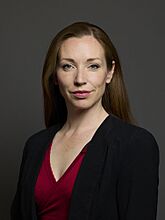 |
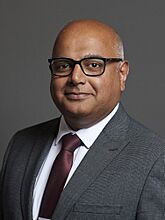 |
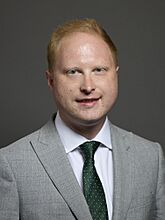 |
| Catherine Atkinson | Baggy Shanker | Jonathan Davies |
| Labour | Labour Co-op | Labour |
City Emblem
Derby's special symbol is the Derby Ram. There's even a folk song about it called "The Derby Ram." You can see it in many places, and it's the nickname for the local football team, Derby County F.C.. The city council's logo is also a ram.
Geography of Derby
Derby is in a fairly flat area along the lower valley of the River Derwent. This is where the hills of the Pennines meet the flatter lands of the River Trent to the south. The city is surrounded by different natural areas, including the Trent Valley Washlands and the Derbyshire Peak Fringe.
Derby is about 16 miles (26 km) from Coton in the Elms, which is the farthest place from the coast in the United Kingdom.
Derby Urban Area
The Derby Built-up Area (BUA) includes Derby and nearby developed areas like Borrowash and Duffield. The Office for National Statistics defines an urban area as built-up land, with close areas linked if they are within 200 meters. In 2011, this area had a total population of 270,468. This was an increase of over 10% since the 2001 census.
For the 2011 census, areas like Breadsall, Duffield, and Little Eaton were included. However, Quarndon is not part of it because it's slightly too far away. The urban area also extends south into small parts of the South Derbyshire district.
| Urban subdivision | Population | District | |
|---|---|---|---|
| 2001 census | 2011 census | ||
| Derby | 229,407 | 255,394 | City of Derby |
| Borrowash | 5,621 | 7,335 | Erewash |
| Duffield | 5,046 | Amber Valley | |
| Little Eaton | 1,920 | Erewash | |
| Ockbrook | 1,710 | Erewash | |
| Breadsall | 773 | Erewash | |
| Total | 236,738 | 270,468 | |
Notes:
- Ockbrook was included in the Borrowash figure in 2011.
- The Derby unitary authority population figures for 2001/2011 were 221,716 and 244,625. The ONS subdivision figures in the table also include small nearby areas outside the city boundary.
- Quarndon is considered a separate area, even though it is very close to the BUA.
Green Belt Area
Derby has a "green belt" area to its north and east. This was created in the 1950s to stop the city from merging with surrounding towns and villages. It stretches for several miles into Derbyshire and Nottinghamshire.
Derby's Climate
Derby has a warm and mild climate. It rains even during the driest month. This type of climate is called Cfb in the Köppen climate classification, which is common across the British Isles. The average yearly temperature is 9.7°C, and it rains about 694 mm per year.
The hottest temperature ever recorded in Derby was 34.1°C (93.4°F) at Markeaton Park on 3 August 1990.
| Climate data for Sutton Bonington, 48 m (157 ft) amsl; 1991–2020 normals, extremes 1924–present | |||||||||||||
|---|---|---|---|---|---|---|---|---|---|---|---|---|---|
| Month | Jan | Feb | Mar | Apr | May | Jun | Jul | Aug | Sep | Oct | Nov | Dec | Year |
| Record high °C (°F) | 15.8 (60.4) |
17.9 (64.2) |
22.9 (73.2) |
26.5 (79.7) |
30.0 (86.0) |
32.2 (90.0) |
39.4 (102.9) |
34.8 (94.6) |
30.9 (87.6) |
28.8 (83.8) |
20.0 (68.0) |
15.9 (60.6) |
39.4 (102.9) |
| Mean daily maximum °C (°F) | 7.5 (45.5) |
8.1 (46.6) |
10.5 (50.9) |
13.6 (56.5) |
16.7 (62.1) |
19.6 (67.3) |
22.0 (71.6) |
21.8 (71.2) |
18.7 (65.7) |
14.5 (58.1) |
10.4 (50.7) |
7.8 (46.0) |
14.3 (57.7) |
| Daily mean °C (°F) | 4.7 (40.5) |
5.0 (41.0) |
6.8 (44.2) |
9.1 (48.4) |
11.9 (53.4) |
14.9 (58.8) |
17.1 (62.8) |
17.0 (62.6) |
14.4 (57.9) |
11.0 (51.8) |
7.4 (45.3) |
4.9 (40.8) |
10.3 (50.5) |
| Mean daily minimum °C (°F) | 1.9 (35.4) |
1.9 (35.4) |
3.0 (37.4) |
4.6 (40.3) |
7.2 (45.0) |
10.1 (50.2) |
12.1 (53.8) |
12.2 (54.0) |
10.1 (50.2) |
7.5 (45.5) |
4.4 (39.9) |
2.1 (35.8) |
6.5 (43.7) |
| Record low °C (°F) | −16.7 (1.9) |
−17.8 (0.0) |
−13.3 (8.1) |
−6.7 (19.9) |
−4.4 (24.1) |
−1.1 (30.0) |
1.7 (35.1) |
1.1 (34.0) |
−1.8 (28.8) |
−6.7 (19.9) |
−9.9 (14.2) |
−15.3 (4.5) |
−17.8 (0.0) |
| Average precipitation mm (inches) | 50.7 (2.00) |
41.2 (1.62) |
40.6 (1.60) |
44.3 (1.74) |
46.3 (1.82) |
63.7 (2.51) |
61.8 (2.43) |
54.6 (2.15) |
49.2 (1.94) |
62.7 (2.47) |
56.9 (2.24) |
58.1 (2.29) |
630.0 (24.80) |
| Average precipitation days (≥ 1.0 mm) | 10.9 | 9.6 | 9.6 | 9.6 | 8.9 | 9.5 | 9.6 | 8.6 | 8.9 | 10.4 | 11.0 | 11.7 | 118.3 |
| Mean monthly sunshine hours | 51.6 | 76.1 | 115.6 | 152.0 | 182.9 | 161.8 | 190.1 | 175.6 | 136.7 | 100.8 | 61.5 | 47.7 | 1,452.4 |
| Source 1: Met Office | |||||||||||||
| Source 2: Starlings Roost Weather | |||||||||||||
| Climate data for Derby, extremes 1959–2006 | |||||||||||||
|---|---|---|---|---|---|---|---|---|---|---|---|---|---|
| Month | Jan | Feb | Mar | Apr | May | Jun | Jul | Aug | Sep | Oct | Nov | Dec | Year |
| Record high °C (°F) | 13.5 (56.3) |
17.4 (63.3) |
22.8 (73.0) |
25.2 (77.4) |
27.2 (81.0) |
31.5 (88.7) |
32.7 (90.9) |
34.1 (93.4) |
28.3 (82.9) |
26.8 (80.2) |
18.1 (64.6) |
15.5 (59.9) |
34.1 (93.4) |
| Record low °C (°F) | −16.1 (3.0) |
−12.8 (9.0) |
−13.9 (7.0) |
−6.5 (20.3) |
−5.0 (23.0) |
0.0 (32.0) |
0.5 (32.9) |
2.3 (36.1) |
−1.4 (29.5) |
−4.4 (24.1) |
−6.8 (19.8) |
−10.6 (12.9) |
−16.1 (3.0) |
Nearby Towns and Cities
- Northwest: Buxton, Bakewell, Glossop, Manchester.
- North: Duffield, Belper, Matlock.
- Northeast: Ilkeston, Heanor, Eastwood, Alfreton, Swanwick Clay Cross, Ripley, Mansfield, Chesterfield, Sheffield.
- East: Nottingham, Borrowash, Breaston, Long Eaton, Beeston, Ockbrook.
- West: Ashbourne, Uttoxeter, Stoke on Trent.
- Southwest: Burton on Trent, Lichfield, Birmingham.
- South: Swadlincote, Castle Donington, Melbourne, Ashby-de-la-Zouch, Coventry.
- Southeast: Kegworth, Loughborough, Leicester.
Derby's Population and People
| Historical population | ||
|---|---|---|
| Year | Pop. | ±% |
| 1801 | 14,695 | — |
| 1851 | 48,506 | +230.1% |
| 1901 | 118,469 | +144.2% |
| 1921 | 142,824 | +20.6% |
| 1941 | 167,321 | +17.2% |
| 1951 | 181,423 | +8.4% |
| 1961 | 199,578 | +10.0% |
| 1971 | 219,558 | +10.0% |
| 1981 | 214,424 | −2.3% |
| 1991 | 225,296 | +5.1% |
| 2001 | 221,716 | −1.6% |
| 2011 | 248,700 | +12.2% |
Ethnic Groups in Derby
| Ethnic Group | Year | |||||||||||
|---|---|---|---|---|---|---|---|---|---|---|---|---|
| 1971 estimations | 1981 estimations | 1991 | 2001 | 2011 | 2021 | |||||||
| White: Total | 203,415 | 95.2% | 193,963 | 91.5% | 197,658 | 90.3% | 193,881 | 87.4% | 199,751 | 80.3% | 192,871 | 73.8% |
| White: British | – | – | – | – | – | – | 187,104 | 84.4% | 187,386 | 75.3% | 173,077 | 66.2% |
| White: Irish | – | – | – | – | – | – | 3,060 | 2,319 | 1,982 | 0.8% | ||
| White: Gypsy or Irish Traveller | – | – | – | – | – | – | – | – | 295 | 408 | 0.2% | |
| White: Roma | – | – | – | – | – | – | – | – | – | – | 1,163 | 0.4% |
| White: Other | – | – | – | – | – | – | 3,717 | 9,751 | 16,241 | 6.2% | ||
| Asian or Asian British: Total | – | – | – | – | 15,285 | 7% | 19,390 | 8.7% | 31,095 | 12.5% | 40,901 | 15.5% |
| Asian or Asian British: Indian | – | – | – | – | 8,388 | 8,505 | 10,907 | 12,631 | 4.8% | |||
| Asian or Asian British: Pakistani | – | – | – | – | 5,537 | 8,790 | 14,620 | 21,034 | 8.0% | |||
| Asian or Asian British: Bangladeshi | – | – | – | – | 1,45 | 210 | 658 | 827 | 0.3% | |||
| Asian or Asian British: Chinese | – | – | – | – | 557 | 857 | 1,292 | 1,416 | 0.5% | |||
| Asian or Asian British: Other Asian | – | – | – | – | 658 | 1,028 | 3,618 | 4,993 | 1.9% | |||
| Black or Black British: Total | – | – | – | – | 4,653 | 2.1% | 3,895 | 1.8% | 7,320 | 2.9% | 10,482 | 4% |
| Black or Black British: African | – | – | – | – | 235 | 438 | 3,156 | 6,110 | 2.3% | |||
| Black or Black British: Caribbean | – | – | – | – | 3,176 | 3,108 | 3,405 | 3,056 | 1.2% | |||
| Black or Black British: Other Black | – | – | – | – | 1,242 | 349 | 759 | 1,316 | 0.5% | |||
| Mixed or British Mixed: Total | – | – | – | – | – | – | 3,968 | 1.8% | 7,232 | 2.9% | 9,562 | 3.7% |
| Mixed: White and Black Caribbean | – | – | – | – | – | – | 2,293 | 3,916 | 4,178 | 1.6% | ||
| Mixed: White and Black African | – | – | – | – | – | – | 200 | 533 | 924 | 0.4% | ||
| Mixed: White and Asian | – | – | – | – | – | – | 980 | 1,772 | 2,412 | 0.9% | ||
| Mixed: Other Mixed | – | – | – | – | – | – | 495 | 1,011 | 2,048 | 0.8% | ||
| Other: Total | – | – | – | – | 1,206 | 0.5% | 574 | 0.3% | 3,354 | 1.3% | 7,548 | 2.9% |
| Other: Arab | – | – | – | – | – | – | – | – | 861 | 0.3% | 1,032 | 0.4% |
| Other: Any other ethnic group | – | – | – | – | 1206 | 0.5% | 574 | 0.3% | 2,493 | 1% | 6,516 | 2.5% |
| Ethnic minority: Total | 10,296 | 4.8% | 17,947 | 8.5% | 21,144 | 9.7% | 27,827 | 12.6% | 49,001 | 19.7% | 68,493 | 26.2% |
| Total | 213,711 | 100% | 211,910 | 100% | 218,802 | 100% | 221,708 | 100% | 248,752 | 100% | 261,364 | 100% |
Religions in Derby
| Religion | 2001 | 2011 | 2021 | |||
|---|---|---|---|---|---|---|
| Number | % | Number | % | Number | % | |
| Holds religious beliefs | 169,073 | 76.2 | 163,141 | 65.6 | 149,208 | 57.1 |
| 149,471 | 67.4 | 131,129 | 52.7 | 104,949 | 40.2 | |
| 448 | 0.2 | 822 | 0.3 | 828 | 0.3 | |
| 1,354 | 0.6 | 2,198 | 0.9 | 3,065 | 1.2 | |
| 141 | 0.1 | 110 | <0.1 | 150 | 0.1 | |
| 9,958 | 4.5 | 19,006 | 7.6 | 29,137 | 11.1 | |
| 7,151 | 3.2 | 8,891 | 3.6 | 9,762 | 3.7 | |
| Other religion | 550 | 0.2 | 985 | 0.4 | 1,297 | 0.5 |
| No religion | 35,207 | 15.9 | 68,668 | 27.6 | 95,639 | 36.6 |
| Religion not stated | 17,428 | 7.9 | 16,943 | 6.8 | 16,517 | 6.3 |
| Total population | 221,708 | 100% | 248,752 | 100% | 261,364 | 100% |
Derby's Industries
Derby's two largest employers are Rolls-Royce Holdings and Toyota, both involved in engineering and manufacturing. Other important companies include railway systems engineering firm Alstom, which makes trains at Derby Litchurch Lane Works. First Source handles phone support for Sky UK, and Triton Equity took over Alstom's factory for power plant equipment.
Derby power station, on Silkmill Lane, provided electricity to the town from 1893 until it closed in 1969.
From 1922, Sinfin Lane was home to International Combustion. This company first made machines for delivering fuel to furnaces and boilers. Later, it produced steam-generating boilers for power stations.
Derby was also home to Core Design, the company that created the popular video game Tomb Raider. When Derby's inner ring road was finished in 2010, a part of it was named 'Lara Croft Way' after the game's main character.
One of Derby's oldest businesses is Royal Crown Derby, which has been making beautiful porcelain since the 1750s.
The Midlands Co-operative Society, now part of Central England Co-operative, started in Derby in 1854. It was one of the first co-operatives in the region.
Infinity Park Derby is a planned business park near the Rolls-Royce site in Sinfin. It will focus on aerospace, rail, and automotive technology. In 2014, the government announced it would become an "enterprise zone."
Railway Engineering in Derby
Because the Midland Railway had its main offices and workshops in Derby, railways greatly influenced the town's growth in the Victorian era.
In the 20th century, other industries grew in Derby. Even though Derby led the way in diesel locomotives, new production stopped in 1966. Repair work also decreased, and the locomotive works eventually closed. The land was then redeveloped into Pride Park. Only the buildings visible from Platform 6 of the station remain.
The Carriage and Wagon Works, now owned by Alstom since 2021, continues to build trains. The Railway Technical Centre still hosts railway businesses.
Derby railway station remains an important part of the railway network. East Midlands Railway operates the Derby Etches Park depot, and Network Rail and Rail Operations Group also maintain trains in Derby. On 21 March 2023, it was announced that Derby would be the headquarters of Great British Railways.
Derby is also home to the Derby Railway Engineering Society, founded in 1908 to promote railway engineering knowledge.
Famous Landmarks in Derby
The tower of Derby Cathedral is 212 feet (65 meters) tall. Since 2006, a pair of peregrine falcons have nested there, and you can watch them on webcams.
Derby Gaol is a visitor attraction located in the old dungeons of the Derbyshire County Gaol, which dates back to 1756.
Derby Museum of Making is located in Derby Silk Mill. It showcases Derby's industrial history and technological achievements, including Rolls-Royce aero engines and railway history. The Silk Mill is at the southern end of the 24 km (15 mi) stretch of the River Derwent that became a World Heritage Site in 2001. In 2022, the Museum of Making was nominated for the Art Fund Museum of the Year award.
Pickford's House Museum was built in 1770 by architect Joseph Pickford. It was both his home and his business office. The Derby Museum and Art Gallery displays paintings by Joseph Wright, beautiful Royal Crown Derby porcelain, and exhibits on natural history and local archaeology. Pickford also designed St Helen's House.
The city's skyline changed a lot in 1968 when the inner ring road was built. This road went through St Alkmund's Church and its Georgian churchyard, which were both demolished. Many people still criticize this decision today.
Places to Visit in Derby
- Cathedral Quarter
- Corn Exchange
- Darley Abbey
- Derbion (formerly Intu Derby)
- Derby Arboretum
- Derby Arena
- Derby Canal
- Derby Catacombs
- Derby Cathedral
- Derby Friargate Station (only Handyside Bridge and the bridge across Friargate remain)
- Derby Museum and Art Gallery
- Museum of Making (located in Derby Silk Mill)
- Derby Computer Museum
- St Mary's Church, Derby
- Pickford's House Museum
- Pride Park Stadium (Derby County F.C.) and the old Baseball Ground (now gone)
- River Derwent
- Royal Crown Derby Museum and Factory Tour
- Saint Benedict Catholic School and Performing Arts College secondary school
- St Helen's House, Derby
Getting Around Derby
Railways
Derby is a major railway hub in the country. Derby railway station is served by two main train companies:
- East Midlands Railway runs regular trains between London St Pancras, Leicester, and Sheffield. They also have services to Newark Castle, Nottingham, Crewe, and Matlock.
- CrossCountry operates hourly trains in both directions between Nottingham, Birmingham New Street, and Cardiff Central. The station is also on a main route connecting places in Scotland, the North East, the South West, and the South East of England.
There are also smaller local stations at Peartree and Spondon, but they have limited services.
Buses and Coaches
Derby bus station is the main place for local bus services in and around the city. Many companies run routes, but the main ones are Trentbarton and Arriva Derby. You can travel to places like Belper, Burton-upon-Trent, Ilkeston, Ripley, Nottingham, and Chesterfield.
The city is also on several National Express routes, connecting it to major cities like Birmingham, London, and Leeds.
Roads
The M1 motorway is about 10 miles (16 km) east of Derby. It links Derby to London in the south and to Sheffield and Leeds in the north. Other important roads near Derby include the A6, A38, A50, A52 (which includes Brian Clough Way connecting Derby to Nottingham), and A61.
On 16 March 2011, Mercian Way, the final part of the city's inner ring road, was opened. This new section connects Burton Road with Uttoxeter New Road.
Air Travel
East Midlands Airport is about 15 miles (24 km) from Derby city centre. There was some discussion when the airport added "Nottingham" to its name in 2004, as it's close to Derby and in Leicestershire. In 2006, it went back to its original name.
The airport is used by budget airlines like Ryanair and Jet2, offering flights to places in the UK and Europe. Derby Airfield, about 7 miles (11 km) southwest of the city, has grass runways for smaller planes.
Community and Culture in Derby
On 8 October 2021, Derby was considered for the UK City of Culture 2025 title, but it didn't make the final list in March 2022.
Many locals sometimes call Derby "Derbados," which is a fun mix of Derby and Barbados.
Music Scene
The indie pop band White Town, led by Jyoti Mishra, is from Derby. Their music video for "Your Woman" (which was a number one hit in 1997) shows scenes from the city centre.
Duncan Lloyd, a founding member of the band Maxïmo Park, is from Derby. The band's album Nature Always Wins reached number 2 in the UK charts in 2020.
Pop singer Kelli Young (born 1982), known from the group Liberty X, is also from Derby.
Lucy Ward, a singer-songwriter from Derby, performs traditional English folk songs and her own music. Her albums have received great reviews.
In rock music, blues singer-songwriter Kevin Coyne was from Derby, as are the rock band LostAlone and indie/glam rock band The Struts. The ska punk band Lightyear is also from Derby.
The band Anti-Pasti, whose 1981 album The Last Call reached the top 40, came from Derby.
Sinfonia Viva is a chamber orchestra based in Derby. They perform concerts and educational events in the city and across the East Midlands.
Derby has a lively classical music scene with two choral societies, Derby Bach Choir and Derby Choral Union. There are also smaller choirs and the Derby Concert Orchestra. Derby Chamber Music holds concerts at Derby University. Organ concerts are held every summer at Derby Cathedral.
The folk music scene includes the yearly Derby Folk Festival. Derby Jazz organizes jazz performances and workshops all year.
Other music venues in the city include The Venue, The Hairy Dog, Ryan's Bar, The Flowerpot, and The Victoria Inn.
Theatre and Arts
Derby has had several theatres over the years, including the Grand Theatre.
After some financial difficulties, Derby Playhouse closed in 2008 but reopened later that year. It closed again briefly before Derby University took over and renamed it Derby Theatre. It is now run by the university.
QUAD is an arts and film centre that opened in 2008. It has two cinema screens for independent and mainstream films, art galleries, a digital studio, and spaces for workshops. QUAD also hosts the annual Derby Film Festival and the FORMAT international photography festival.
The Robert Ludlam Theatre, at Saint Benedict Catholic School and Performing Arts College, is a 270-seat venue that hosts dance, drama, music, comedy, and film events. The theatre company Oddsocks is based in Derby and performs in the city and around the country.
Déda, founded in 1991, is the only dedicated dance centre in the East Midlands. It offers dance classes and professional performances for all ages. Déda also partners with the University of Derby for a Dance degree.
The Derby Book Festival, first held in 2015, takes place in late spring/early summer. An "Autumn edition" was added in 2019.
Derby Festé is a weekend street arts festival held every September. The Six Streets Arts trail, which started in 2012, is now a two-yearly event.
The Bafta award-winning actor Jack O'Connell is from Derby. John Dexter, a theatre director, and actor Alan Bates were also from Derby. John Osborne wrote his play Look Back in Anger in 1956 while living in Derby.
Museums in Derby
Derby has several museums to explore:
- Derby Museum and Art Gallery
- Museum of Making (located in Derby Silk Mill)
- Derby Computer Museum
- Pickford's House Museum
Recreation and Parks
Derby Arboretum, given to the town by Joseph Strutt in 1840, was the first planned urban public park in the country. After some neglect, it has been renovated. It is said to have inspired Central Park in New York.
Markeaton Park is Derby's most popular leisure spot. Other large parks include Allestree Park, Darley Park, Chaddesden Park, Alvaston Park, Normanton Park, and Osmaston Park. Derby is thought to have one of the highest amounts of parkland per person in the country.
Derby Rowing Club and Derwent Rowing Club are located on the banks of the River Derwent, which also has a riverside walk and cycle path.
On 10 November 2021, Derby City Council approved plans for the UK's first large-scale urban rewilding project in Allestree Park.
Sports in Derby
Derby became well-known in sports after Brian Clough became manager of Derby County F.C. in 1967. The team was promoted to the top football league in 1969 and won the English league title three years later. After Clough left, Dave Mackay led Derby County to another league title in 1975. This is still the club's last major trophy. The club moved from its old Baseball Ground in 1997 to the new Pride Park Stadium.
There are three senior non-league football clubs in the city: Mickleover Sports, Graham Street Prims, and Borrowash Victoria.
Derbyshire County Cricket Club plays most of its home matches at the County Ground in Derby. They won the County Championship once, in 1936.
Derby has clubs for both types of rugby. In rugby union, Derby RFC plays at Haslams Lane. The rugby league team Derby City RLFC was formed in 1990.
The city's basketball team, Derby Trailblazers, plays in the English Basketball League Division One. They were formed in 2002.
Team Derby, based at Derby Arena, won the first National Badminton League title in 2014–15. The Arena, opened in 2015, also has a velodrome for cycling events.
In the late 1800s, local industrialist Francis Ley tried to introduce baseball to Derby. He built a stadium for it, which later became the home of Derby County Football Club for about 100 years. It was taken down in 2003.
Professional golfer Melissa Reid was born in Derby in 1987. She plays on the Ladies European Tour.
Arthur Keily, a marathon runner and Olympian, was born in Derbyshire in 1921 and has lived in Derby his whole life. In the 1960 Rome Olympics, he set an English Olympic record.
Shopping and Nightlife in Derby
Shopping in central Derby is split into three main areas: the Cathedral Quarter, the St Peters Quarter, and the Derbion shopping centre. The Cathedral Quarter has many unique shops, boutiques, coffee shops, and restaurants. It's located around the cathedral and areas like Irongate and Sadler Gate.
The St Peters Quarter also has a variety of shops, including many independent businesses. St Peters Street, London Road, and East Street offer a wide choice of national stores, pubs, and restaurants.
Derbion is the city's main indoor shopping centre. It opened in 2007 after a large expansion. It has a food court and a 12-screen cinema. Some people felt that this new centre took business away from older parts of the city.
The Friar Gate area is known for its clubs and bars, making it the centre of Derby's nightlife. Derby also has many pubs and is famous for its large number of real ale outlets. The oldest pub is the Grade II listed Ye Olde Dolphin Inne, which dates back to the late 1500s.
Outside the city centre, there are shopping areas like Kingsway Retail Park, Wyvern Retail Park, and the Meteor Centre.
Education in Derby
Like most of the UK, Derby has a non-selective education system. Children attend infant and junior school (often combined into a primary school) before moving to a secondary school. Many secondary schools have sixth forms, where students can study for A Levels after finishing compulsory education.
For those who want to continue their education but leave school, Derby College offers courses for school leavers, apprentices, and job-related training. It has two main campuses: the Joseph Wright Centre for A Levels, and the historic Derby Roundhouse for vocational training like engineering and catering.
Derby has 16 state secondary schools, including Allestree Woodlands School, Chellaston Academy, and Landau Forte College.
There are also three independent (fee-paying) schools. Derby Grammar School was founded in 1994 and now accepts both boys and girls. Derby High School became fully co-educational in 2023.
Derby also has special needs schools like Ivy House School and the Light House. Some mainstream schools, like Allestree Woodlands School and Saint Benedict, have special departments for students with hearing impairments or other needs.
The University of Derby has its main campus on Kedleston Road. There is also a campus in Buxton. In 2003, the University of Nottingham opened a medical school at Royal Derby Hospital.
Media in Derby
The Derby Telegraph is the city's daily newspaper. Crime writer Richard Cox based his first book on his experiences as a Derby Telegraph reporter in the 1970s.
BBC Radio Derby, the BBC's local station for Derbyshire, is based in the city. It provides local, national, and international news, music, and sports. You can listen on 104.5 FM and 1116 AM, or online. The BBC also has a local website for Derby with news, travel, and weather.
Local TV news and programmes are provided by BBC East Midlands and ITV Central.
Capital Midlands (formerly Capital East Midlands and Ram FM) is the biggest commercial radio station in the city. It broadcasts on 102.8 FM and plays popular chart hits for younger listeners.
Notable People from Derby
Arts, Literature, and Music
- Samuel Richardson (1689–1761), writer and printer.
- Joseph Wright of Derby (1734–1797), famous painter.
- John Raphael Smith (1751–1812), painter and engraver.
- William Billingsley (1758–1828), porcelain painter.
- Elizabeth Bridget Pigot (1783–1866), friend and source for Lord Byron's life.
- Ernest Townsend (1880–1944), portrait artist.
- Marion Adnams (1898–1995), painter and printmaker.
- Ronald Binge (1910–1979), composer.
- Eric Malpass (1910–1996), novelist.
- John Dexter (1925–1990), theatre and film director.
- Kevin Coyne (1944–2004), musician and writer.
- Peter Hammill (born 1948), singer-songwriter.
- Jyoti Mishra (born 1966), sole member of White Town.
- Graham Coxon (born 1969), musician from Blur, lived nearby as a child.
- Lucy Ward (born 1989), folk musician.
- Kelli Young (born 1982), singer from Liberty X.
Films, Theatre, TV, and Radio
- Ted Moult (1926–1986), farmer and TV personality.
- Patricia Greene (born 1931), radio actress in The Archers.
- Alan Bates (1934–2003), actor.
- Gwen Taylor (born 1939), actress.
- Judith Hann (born 1942), presented BBC's Tomorrow's World.
- Richard Felix (born 1949), paranormal investigator.
- Maxwell Caulfield (born 1959), actor.
- Michael Socha (born 1987), actor.
- Jack O'Connell (born 1990), Bafta-winning actor.
- Lauren Socha (born 1990), actress in Misfits.
- Munya Chawawa (born 1993), comedian.
- Ewan Mitchell, actor in The Last Kingdom and House of the Dragon.
Academics, Science, Business, and Engineering
- John Flamsteed (1646–1719), the first Astronomer Royal.
- George Sorocold (c. 1668 – c. 1738), engineer.
- John Lombe (1693–1722), silk spinner.
- John Whitehurst (1713–1788), clockmaker and scientist.
- Jedediah Strutt (1726–1797), hosier and cotton spinner.
- Erasmus Darwin (1731–1802), physician and philosopher.
- Henry Cavendish (1731–1810), scientist who discovered hydrogen.
- Joseph Pickford (1734-1782), architect.
- Andrew Handyside (1806–1887), iron founder.
- Sir Charles Fox (1810–1874), civil engineer.
- Florence Nightingale (1820–1910), pioneer of modern nursing.
- Herbert Spencer (1820–1903), philosopher.
- Sir Henry Royce (1863–1933), co-founder of Rolls-Royce.
- Melvyn Morris (born c. 1957), businessman and former owner of Derby County F.C..
Politics, Religion, and Law
- Joan Waste (1534–1556), a blind woman burned for her Protestant faith.
- Samuel Plimsoll (1825–98), politician and inventor of the Plimsoll line.
- Alice Wheeldon (1866–1919), pacifist and anti-war campaigner.
- Dame Margaret Beckett (born 1943), Labour politician, MP for Derby South since 1983.
Sports
- Steve Bloomer (1874–1938), famous footballer for Derby County.
- Reg Parnell (1911–1964), racing driver.
- Louis Martin (1936–2015), Olympic silver medallist in weightlifting.
- Mark Hateley (born 1961), former footballer.
- Sir Dave Brailsford (born 1964), cycling administrator.
- Melissa Reid (born 1987), professional golfer.
- Jonathan Joseph (born 1991), England rugby player.
- Jamaal Lascelles (born 1993), footballer and captain of Newcastle United.
- Sandy Ryan (born 1993), professional boxer.
- Sarah Vasey (born 1996), swimmer and Commonwealth Games gold medallist.
International Connections
Osnabrück Partnership
Derby is twinned with Osnabrück in Germany. The partnership agreement was signed on 17 February 1976.
Each year, Derby and Osnabrück send an envoy to live in the twin city for twelve months. This envoy helps share ideas between the cities and teaches people about the twinning program. They give talks, help people find pen friends, and plan trips.
There's also an annual exchange between the wind bands of John Port Spencer Academy in Etwall and its twin school, Gymnasium Melle, in Melle. An exchange also started in 2009 between Allestree Woodlands School and the Gymnasium Angelaschule in Osnabrück, focusing on language and culture.
The exchange of envoys between cities is quite rare. Osnabrück also sends envoys to Angers and Çanakkale. In Britain, only Wigan also takes part in this envoy exchange.
List of Twin Towns
- Osnabrück, Germany
- Kapurthala, India (friendship link)
- Haarlem, Netherlands (friendship link)
- Foncquevillers, France (friendship link)
- Toyota City, Japan
- Changzhi, People's Republic of China (Memorandum of Understanding)
- Keene, New Hampshire, (Keene State College student exchange programme)
- Hebron, Palestine (2014)
Freedom of the City
The following people and military groups have received the Freedom of the City of Derby. This is a special honor given by the city.
Individuals Honored
- Brian Howard Clough: 3 May 2003.
- Adam George Peaty: 9 October 2016.
- Reginald Frederick Harrison: 5 February 2019.
- Sandy Ryan: 25 March 2024.
- Stephen "Steve" Kirk: 15 April 2024.
Military Units Honored
- The Royal Naval Submarine Service: 28 April 2002.
- The Mercian Regiment: 2007.
See also
 In Spanish: Derby para niños
In Spanish: Derby para niños


